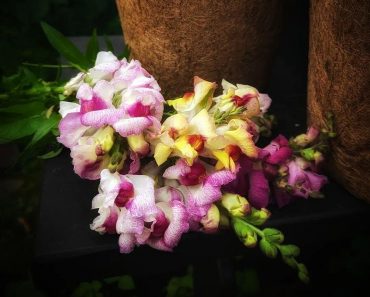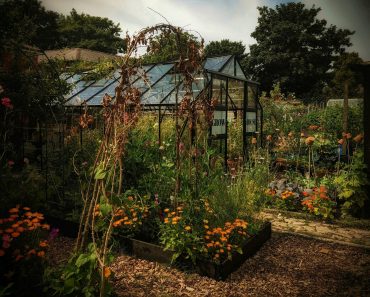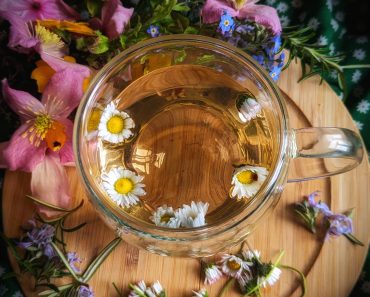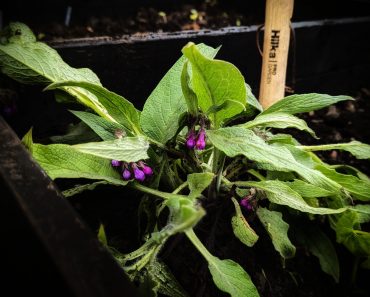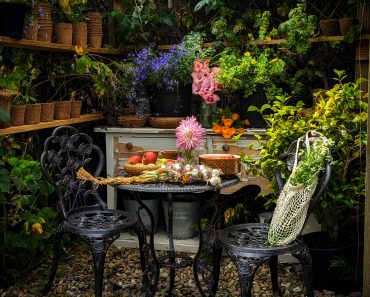Learn How to grow Courgettes from seed. My favourite is the Golden Yellow Courgette! Spectacular vibrant vegetables that I thoroughly enjoy growing year after year….look at my Face! A proud gardener right there!
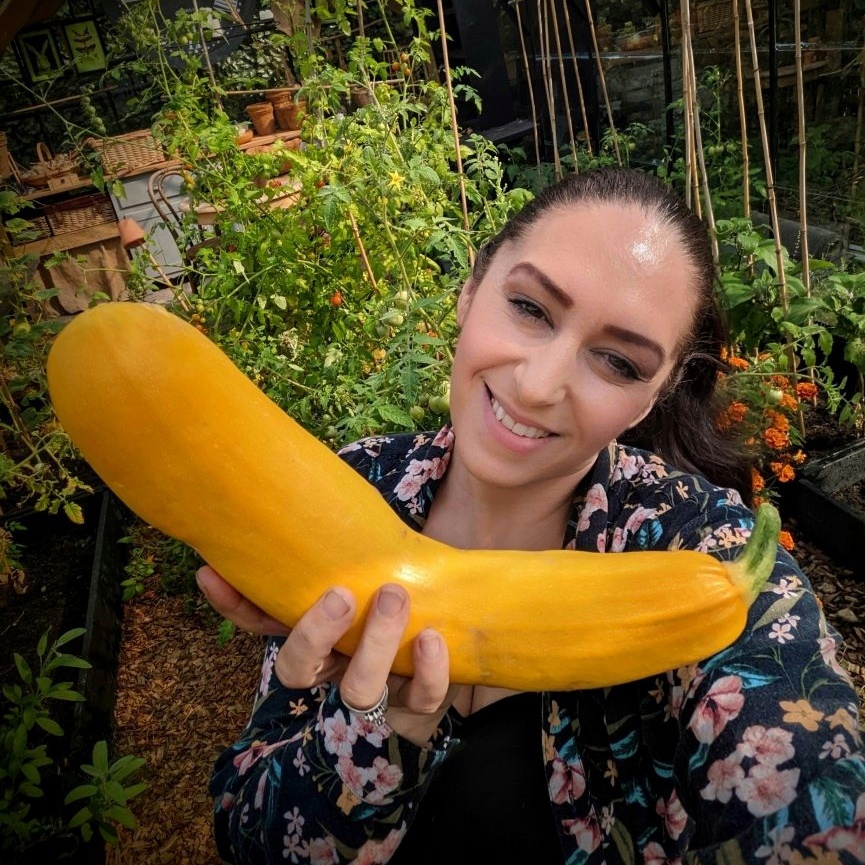
This post may contain affiliate links please see my disclosure policy
Giant Veg Shot!
Full disclosure- the Courgette above is far bigger than my average Courgettes, this monster had been hiding the whole time and wasn’t discovered until the end of the season. It was delicious all the same! However, I generally prefer to pick courgettes when they are relatively small for the best flavour. This is just a token ‘big veg shot’ that us gardeners love to take!
Why I Love growing Courgettes

Courgettes are a summer staple in most English vegetable gardens. They are also quite easy to grow and a very adaptable food, they can be added Raw to Salads, pickled, baked, steamed or grilled. The courgette plant is also abundant, providing a glut of Courgettes from a single seed. In fact the more you harvest from your Courgette plant, the more it provides…believe me!
Courgette History
Courgettes, a member of the squash family, were first grown in Central America, eventually landing on European shores in the pockets of Spanish sailors. Their first mention in European literature was in Milan in 1901, it was from that moment that the Courgette (Or ‘Zucchini’) began to gain popularity.
Basically a Marrow!
Courgettes are technically an under developed Marrow and Marrows have been grown in England for at least 2 centuries, so when the Courgette, a somewhat long lost smaller cousin of the Marrow came to British lands in the 1960’s , it was an easy transition and welcomed for its milder more palatable taste than the chunky marrow.
*Fun Fact
The words “Courgette” and “Zucchini” are both diminutive of the word “Marrow”. Courgette is derived from the French word, while Zucchini is derived from the Italian word.
Zucchini or Courgette?
The name Zucchini is mainly used in America, Australia, Canada and New Zealand.
The name Courgette is most popular in England, Malaysia, South Africa and Poland.
Courgette varieties
Affiliate links
There are many Courgette varieties, here are just a few recommended varieties to try:
- Golden Yellow Courgette
- Black Beauty Courgette
- Courgette Ambassador
- Courgette Romanesco
How to Grow Courgettes

How to Sow Courgette Seeds
- Sow Courgette seeds indoors from mid to late April around 1/2 inch deep in modules or pots of compost.
- Place on a Sunny Windowsill with a propagator lid or cover with cling film until germination occurs.
- Harden off young plants before planting out in late May/Early June after the last frost for your area.
Sow Outdoors
- Outside, sow 2 or 3 seeds around 1 inch deep in late May or early June
- Cover with a cloche. Thin out seedlings keeping only the strongest ones.
What Does Hardening Off Mean?
Plants raised indoors or in a greenhouse environment, need to be acclimatised to cooler temperatures and increased air movement for about two to three weeks before they are planted outdoors permanently . This is a ‘toughening up’ practice to prepare the plants for their new environment.
How to Harden Off
Place your plants out for a couple of hours in a shady part of the garden. The next day, leave them out again for two hours, but this time allow the plants an hour of direct sunshine in the morning. Gradually continue to increase the length of time the plants are in direct sunshine over the course of roughly two weeks.
Light and Water Requirements
Courgettes prefer a sheltered position (they do very well in Greenhouses as well as outdoors) Plant in a full sun position and in a fertile soil that holds plenty of moisture.
Courgettes are very thirsty plants so water frequently to ensure a healthy crop. *Top Tip, water at the base, directly to the roots, allowing water to settle on the plant can lead to rotting, increasing the chances of powdery mildew.
Give them Space
Courgette plants grow quite large, for healthy air circulation make sure there is plenty of room for them to spread out
Feed Them
For an extra boost add a mix of compost and well rotted manure to the planting hole. Once the first fruit starts to grow, feed every 2 weeks with a high potassium feed.
When to Harvest Courgettes
For the best flavour harvest young! 10=15 cm in length is ideal
Common Courgette Problems
1.Grey Mould
Grey mould is a fungal disease that appears as a powdery grey mould on the stalk of courgettes(this problem is most common on vegetables grown under glass, due to the high humidity levels) The fuzzy grey mould will gradually cover the whole fruit, destroying any chance of a harvest. I have listed below some options for helping resolve this issue:
- Prevention is always easier than cure so try to space the courgette plants out well to allow for good air circulation.
- Remove any affected fruit
- Remove any dead leaves or flowers.
- Water at root level not from above
2.Powdery Mildew
Powdery mildew is a common problem. Powdery Mildew is a fungal disease that presents as a white powdery substance on the leaves, it can unfortunately stunt growth and cause the leaves to shrivel. Here are some ways to remedy the problem:
- Under watered drought-stressed plants are more susceptible so dig in some organic material into the planting hole before transplant, this will help improve the soil and provide better water retention.
- Give the plants plenty of room, air circulation is so important especially for dense Courgette plants.
- Remove any affected growth as soon as possible
- Water regularly at the base of the plant, not from above.
3.Rotting Courgettes
When Courgette fruits begin to grow, but then rot or drop off the plant while still small, it is generally due to the fact that the flowers were not pollinated. You will find this is more of an early season issue and it will usually correct itself as the season continues. However, if the problem persists, try hand pollinating your Courgette plant.
How to Hand Pollinate Courgette Plants
- Take a small paint brush or cotton bud and swipe the inside of the male flower to get the pollen. The pollen will be on the stamen (the male reproductive organ of the flowering plant).
- Then brush the collected pollen onto the pistil ( the female reproductive organ) of the female flower.
Determining the Male and Female flowers on the Courgette Plant
- The male flowers of the Courgette plant are the ones with the short stems.
- The female flowers have longer stems and a fruit like swelled area at the base of the flower

Slugs and snails
The gardeners nemesis! Slugs and snails will happily chomp away at the leaves of young courgette plants, kindly leaving their tell-tale slime trails behind just to mock you! You will never get rid of them completely, but here are some methods I have used in the past to lessen their damage:
- Check plants in the evening and remove any slugs and snails by hand.
- Scatter broken egg shells around the base of the Courgette plant
- Cover the soil around the plant with wool slug pellets
Want to learn more about growing your own food?
- How to Grow Neckargold Beans
- How to grow Brussels Sprouts
- How to Grow Zombie Pumpkins
- How to Grow Lemon Cucumber
- How To Grow SweetCorn
- How To Grow Broccoli in Pots
- How To Grow Spring onions
- How To Grow Analena Lettuce
- How To Grow Chives
Creating A Garden ? Take a look at these Frugal DIY Posts…
How To Make A Potting Bench From Scrap Materials
Potting shed made from old doors!
10 ways to create a vertical Garden
How to Build a Bee hotel from Pallet wood
How To Make A Rustic Fence with Tree Branches
How To make a garden arch with tree branches
Looking For more ‘Homely’ Inspo ?
Have a Nosey Around the Blog! See what i’ve been Baking, Growing and Drinking! Also, pop over and say Hi on Instagram

